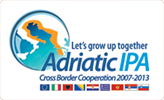Recent increased demand for platy limestone materials for building restoration across the entire eligible project area has placed new demands on quarrying and related extraction efforts. Hence, the need to assess sites in terms of natural heritage and economic viability has become increasingly important.
All member countries observe some form of hierarchical government structure, with the national government at the apex and the legal and administrative structures following the “cascade” principle, i.e. regional, county, and local law and practices, which are consistent with the larger national and, in particular, European policies.
Various negative impacts related to the extensive exploitation of platy limestone include deforestation, changes in hydrological or hydrogeological conditions and quality, and transformations of landscape and habitat that aggravate the colonization of invasive species, introduce noise, vibration and similar disturbances. However, large swaths of the eligible areas are protected by different European, national and local laws (Natura 2000, etc.).
Possible obstacles to extraction of platy limestone in the project area concern:
- The exploitation of platy limestone may have a negative impact on the nature (e.g. destruction of species and habitat types that affect the integrity of the larger ecological network, defacing of the natural landscape, depletion of natural resources, etc.).
- During the exploitation of platy limestone certain rare and valuable fossils and/or minerals as well as speleological objects deemed important in terms of nature heritage could be found.
For non-commercial purposes, it could be useful to exploit platy limestone in some pre-determined sites and in certain prescribed volumes, without having to gain mining rights.
All exploitation areas with mining rights are obliged to provide an Environmental Assessment
All exploitation areas with mining rights are obliged to provide an Environmental Assessment to avoid possible undesirable impact on the environment.
The use of non-autochthonous (outside the Dinaric Karst area) platy limestone must be seen as absolutely unacceptable. However, if the platy limestone in a particular site can not be extracted, the stones could be exploited elsewhere, providing the geological characteristics are the same. Thanks to the geological outputs produced in the frame of the WP3, it has been pointed out that in Italy and Slovenia, platy limestone originates from the same geological units, as does the entire stratigraphical sequence. In Croatia and Bosnia-Herzegovina, however, the geological units are largely different in terms of age, fossil content and lithological characteristics.
For these reasons it is recommended, in the first instance, to re-use and recycle platy limestone plates from old abandoned dilapidated houses, abandoned materials and/or inactive quarries.
We wish to promote the continued use of platy limestone together with the protection of natural heritage by preserving and maintaining the typical karst cultural landscape.
In the frame of the RoofOfRock project, the limestone quarries present in all of the four countries of the eligible area (Italy, Slovenia, Croatia, Bosnia-Herzegovina) have been surveyed and inventoried. A field form has been specially designed for fieldwork in order to characterize – from the lithological, geomorphological, paleontological and legislative point of view – all of the quarries in which platy limestone layers have been observed. Possible conflicts with various existing legislation issues have been verified.
According to the obtained results and taking into consideration various scenarios arising out any conflicts between exploitation and preservation, nine quarries/delves/significant outcrops for sustainable exploitation of small quantities of platy limestone have been identified and are described below.
Italy
The occurrence of platy limestone is extremely limited in the Italian part of the project area.
In the frame of the RoofOfRock project, 24 quarries with limited horizons of platy limestone have been observed; of these 16 lie in areas that are in some way protected or have some related issues or limitations. The remnants quarries here do not exhibit adequate quantities of material for extraction.
However, small quantities of thin limestone slabs are widespread over all the Italian part of the Carso/Kras, and are gathered as waste materials in many quarries.
In the case of restoration of a typical karst house (or church) or the building of a new one, it is suggested to resort to nearby Slovenia if there is no possibility of re-using old plates, opening a new quarry or exploiting an abandoned one.
One of the outputs of the project is the geological characterization and mapping of the platy limestone units across the entire Adriatic Karst Region: in this framework the geologists have emphasized that the platy limestone horizons in Slovenia and Italy belong to the same geological formation and are practically identical. This is why, should the need arise, it is suggested to create a common market and a small, sustainable exchange of limited quantities of platy limestone between Slovenia and Italy.
Slovenia
After careful consideration of the situation in the field and assessment of the quality of platy limestone slabs, two areas for limited exploitation with a need for synchronous paleontological monitoring have been recognized:
- the surrounding area of Komen – microlocation Gabrovica
- Mrtvaški hrib hill – along the local road between Komen and Škrbina
In all other locations there are relatively small outcrops of platy limestone on or near the surface, or the platy limestone is characterized as of poor quality. Given the predominantly horizontal or sub-horizontal bedding, the acquisition of platy limestone in large areas should be re-opened. However, from an environmental standpoint this is virtually impossible in the Kras/Carso area, since most the entire Kras region falls under Nature 2000 protection and special permits would be required. Even in the above- proposed sites it is not possible to excavate large quantities of high-quality platy limestone slabs.
Croatia
For small quantities of platy limestone, the following possible sites for extraction have been identified:
- Bale/Valle (Istra/Istria),
- Benkovac area (between the village of Smilčići and Mejanica hill, Zadar County),
- Vestac and Podgažul (Island of Brač, Split County),
- Koludrovi doci, Kupište and between Grohote and Necujam (Šolta Island, Split County),
- Lovište and Donja Nakovana (western side of the Pelješac peninsula, Dubrovnik County),
- Pupnat (Korčula Island, Dubrovnik County).
Western Herzegovina
After careful consideration of the situation in the field and assessment of the quality of platy limestone slabs and the absence of natural protection requirements, the following sites have been deemed suitable for the exploitation of platy limestone: the Podveležje site (east of the city of Mostar and the village of Dobrć), the Dretelj-Zvirovići site (northwest of Čapljina), the Drinovci site (south of Grude), the area around the Raška Gora and Vrdi sites (north of Mostar); the Polog (Žovnica) site (west of Mostar); and the Borićevac site (northeast of Posušje).
Among these, the most representative is:
- Dretelj-Zvirovići (northwest of Čapljina).












